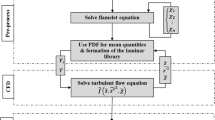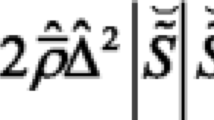Abstract
In the present study, OpenFOAM software was adopted to implement a solver using the Steady Laminar Flamelet Model (SLFM) and Eddy Dissipation Concept (EDC) combustion models. Afterward, the compatibility of fast chemistry-based combustion models consisting of the Infinitely Fast Chemistry, Eddy Dissipation Model (EDM), EDC, and SLFM combustion models was studied in the simulation of 2.7 MW methane pool fire, by employing a one-equation sub-grid-scale turbulence model. Comparing the results against experimental data indicates that the SLFM model anticipates more flame width, and it is capable of predicting the mean turbulent kinetic energy with the maximum error of 4–8%. On the other hand, the EDM model can attain the mean vertical velocity of the flow in the range of 5–10% which is more accurate than the other models. Furthermore, the puffing frequency was derived by the Fast Fourier Transform analysis of vertical velocity, pressure, and temperature in a given time for each of these models. EDM and EDC combustion models illustrated a relative error of 7%, in predicting puffing frequency, compared to experimental results.









Similar content being viewed by others
Abbreviations
- EBU:
-
Eddy breakup model
- EDC:
-
Eddy dissipation concept
- EDM:
-
Eddy dissipation model
- FDS:
-
Fire dynamic simulator
- FFT:
-
Fast Fourier transform
- HHR:
-
Heat release rate
- IFC:
-
Infinitely fast chemistry
- LES:
-
Large eddy simulation
- PDF:
-
Probability density function
- PIV:
-
Particle image velocimetry
- SGS:
-
Sub-grid scale
- SLFM:
-
Steady laminar flamelet model
- VHS:
-
Volumetric heat source
- \({{c}_{p}}\) :
-
Specific heat (J/K)
- D :
-
Pool diameter (m)
- \({{D}_{z}}\) :
-
Mixture’s molecular diffusion coefficient
- f :
-
Frequency of puffing cycle (Hz)
- g :
-
Gravitational Constant (\({{\mathrm{m}^{3}}}/\)kg s)
- \({{k}_{\mathrm{sgs}}}\) :
-
Sub-grid-scale turbulent kinetic energy (\({{\mathrm{m}^{2}}}/{{\mathrm{s}^{2}}}\))
- L :
-
Height of the flame (m)
- \({{L}^{\mathrm{base}}}\) :
-
Characteristic length scale of pool fire (m)
- P :
-
Pressure (kPa)
- \({P}_{\infty }\) :
-
Ambient pressure (kPa)
- \(\dot{Q}\) :
-
Fire heat release rate (W)
- Sc:
-
Schmidt number
- \({{T }_{\infty }}\) :
-
Ambient air temperature (K)
- T :
-
Temperature (K)
- \({{\tilde{u}}_{i}}\) :
-
ith component of filtered velocity (m/s)
- \({{W}_{i}}\) :
-
Molecular weight of ith species (kg/mol)
- X :
-
Length of the domain (m)
- Y :
-
Height of the domain (m)
- \({{Y}_{i}}\) :
-
Mass fraction of ith species
- Z :
-
Width of the domain (m)
- \(\widetilde{z}\) :
-
Filtered mixture fraction
- \(\widetilde{{{z}''}}\) :
-
Filtered variance of mixture fraction
- \(\bar{\rho }\) :
-
Averaged density (kg\(/{{\mathrm{m}^{3}}}\))
- \({{\rho }_{\infty }}\) :
-
Ambient density (kg\(/{{\mathrm{m}^{3}}}\))
- \(\chi \) :
-
Scalar dissipation rate (\({\mathrm{s}^{-1}}\))
- \({\chi }_{\mathrm{st}}\) :
-
Stoichiometric scalar dissipation rate (\({\mathrm{s}^{-1}}\))
- \(\mu \) :
-
Dynamic viscosity (\({\mathrm{N}\,\mathrm{s} {\mathrm{m}^{2}}}\))
- \({\mu }_{\mathrm{t}}\) :
-
Turbulent dynamic viscosity (\({\mathrm{N}\,\mathrm{s} {\mathrm{m}^{2}}}\))
- \({{\omega }_{i}}\) :
-
Production rate of ith species (\({\mathrm{kg}\,{\mathrm{m}^{3}}}/\mathrm{s}\))
- \({{{\bar{\omega }}'''}_{F}}\) :
-
Mean reaction rate (\({\mathrm{kg}\,{\mathrm{m}^{3}}}/\mathrm{s}\))
- \({{\varepsilon }_{\mathrm{sgs}}}\) :
-
Sub-grid-scale dissipation of turbulent kinetic energy (\({{\mathrm{m}^{2}}}/{{\mathrm{s}^{3}}}\))
- \(\lambda \) :
-
Thermal conductivity coefficient (\(\mathrm{W}/{\mathrm{m}\,\mathrm{K}}\))
References
Dhurandher BK, Ravi D et al (2017) An experimental study of vertical centreline temperature and velocity profile of buoyant plume in cubical compartment. J Braz Soc Mech Sci Eng 39(5):1813–1822
Ahmadi O, Mortazavi SB, Pasdarshahri H et al (2019) Modeling of boilover phenomenon consequences: computational fluid dynamics (CFD) and empirical correlations. Process Saf Environ Prot 129:25–39
McGrattan K, Hostikka S et al (2013) Fire dynamics simulator technical reference guide volume 1: mathematical model. NIST Spec Publ 1018(1):175
Novozhilov V (2001) Computational fluid dynamics modeling of compartment fires. Prog Energy Combust Sci 27(5):611–666
Hostikka S, McGrattan KB (2001) Large eddy simulation of wood combustion. Proceedings of the Ninth International Interflam Conference, pp 755–762
Huang YL, Shiu HR, Chang SH et al (2008) Comparison of combustion models in cleanroom fire. J Mech 24(3):267–275
Maragkos G, Beji T, Merci B (2017) Large eddy simulations of CH\(_4\) fire plumes. Flow Turb Combust 99(1):239–278
Maragkos G, Beji T, Merci B (2017) Advances in modelling in CFD simulations of turbulent gaseous pool fires. Combust Flame 181:22–38
Weckman EJ, Strong AB (1996) Experimental investigation of the turbulence structure of medium-scale methanol pool fires. Combust Flame 105(3):245–266
Wen JX, Huang LY, Roberts J (2001) The effect of microscopic and global radiative heat exchange on the field predictions of compartment fires. Fire Saf J 36(3):205–223
Rawat R, Pitsch H, Ripoll JF (2002) Large-eddy simulation of pool fires with detailed chemistry using an unsteady flamelet model. In: Proceeding of the summer program. Center for Turbulence Research
Desjardin PE (2005) Modeling of conditional dissipation rate for flamelet models with application to large eddy simulation of fire plumes. Combust Sci Technol 177(10):1883–1916
Tieszen SR, O’hern TJ (2002) Experimental study of the flow field in and around a one meter diameter methane fire. Combust Flame 129(4):378–391
DesJardin PE, O’Hern TJ, Tieszen SR (2004) Large eddy simulation and experimental measurements of the near-field of a large turbulent helium plume. Phys Fluids 16(6):1866–1883
Marchand A, Verma S, Xu R et al (2019) Simulations of a turbulent line fire with a steady flamelet combustion model coupled with models for non-local and local gas radiation effects. Fire Saf J 106:105–113
Yuen ACY, Yeoh GH, Timchenko V et al (2016) Study of three LES subgrid-scale turbulence models for predictions of heat and mass transfer in large-scale compartment fires. Numer Heat Trans Appl 69(11):1223–1241
Yuen ACY, Yeoh GH, Timchenko V et al (2016) Importance of detailed chemical kinetics on combustion and soot modelling of ventilated and under-ventilated fires in compartment. Int J Heat Mass Trans 96:171–188
Yuen ACY, Yeoh GH, Timchenko V et al (2017) On the influences of key modelling constants of large eddy simulations for large-scale compartment fires predictions. Int J Comput Fluid Dyn 31(6–8):324–337
Heidarinejad G, Pasdarshahri P, Safarzadeh M (2019) The importance of using the combustion and sub-grid model in modelling of large pool fire flow field. Amirkabir J Mech Eng (in Persian)
Poinsot T, Veynante D (2005) Theoretical and numerical combustion. RT Edwards Inc., Murarrie
White JP, Vilfayeau S et al (2017) Modeling flame extinction and reignition in large eddy simulations with fast chemistry. Fire Saf J 90:72–85
Merci B, Maragkos E, Mura A (2010) Modeling of turbulent combustion. Handbook of combust: Online, pp 175–203
Kassem H, Saqr K et al (2011) Implementation of the eddy dissipation model of turbulent non-premixed combustion in OpenFOAM. Int Commun Heat Mass Trans 38(3):363–367
Ertesvåg IS (2019) Analysis of some recently proposed modifications to the eddy dissipation concept (EDC). Combust Sci Technol. https://doi.org/10.1080/00102202.2019.1611565
Peters N (1984) Laminar diffusion flamelet models in non-premixed turbulent combustion. Prog Energy Combust Sci 10(3):319–339
Peters N (1988) Laminar flamelet concepts in turbulent combustion. Symp Combust 21(1):1231–1250
Pierce CD, Moin P (2004) Progress-variable approach for large-eddy simulation of non-premixed turbulent combustion. J Fluid Mech 504:73–97
Design Reaction (2011) CHEMKIN Tutorials Manual CHEMKIN® Software. 10112/15112
Müller H, Ferraro F, Pfitzner M (2013) Implementation of a steady laminar flamelet model for non-premixed combustion in LES and RANS simulations. In: International OpenFOAM workshop
Jiménez C, Ducros F et al (2004) Subgrid scale variance and dissipation of a scalar field in large eddy simulations. Phys Fluids 13(6):1748–1754
Han W, Scholtissek A, Hasse C (2019) The role of tangential diffusion in evaluating the performance of flamelet models. Proc Combust Inst 37(2):1767–1774
Yeoh GH, Cheung SCP et al (2011) Comparative Large Eddy Simulation study of a large-scale buoyant fire. Phys Fluids 47(9):1197–1208
Cook AW, Riley J (1994) A subgrid model for equilibrium chemistry in turbulent flows. Phys Fluids 6(8):2868–2870
Moukalled F et al (2016) The finite volume method in computational fluid dynamics. Springer International Publishing, Switzerland
Quintiere J (2006) Fundamentals of fire phenomena. Wiley, Hoboken
Cetegen BM, Tarek A (1993) Experiments on the periodic instability of buoyant plumes and pool fires. Combust Flame 93(1–2):157–184
Moreno-Boza D, Coenen W et al (2018) On the critical conditions for pool-fire puffing. Combust Flame 192:426–438
Hu L, Hu J, de Ris JL (2015) Flame necking-in and instability characterization in small and medium pool fires with different lip heights. Combust Flame 162(4):1095–1103
O’hern TJ, Weckman EJ et al (2005) Experimental study of a turbulent buoyant helium plume. Phys Fluids 544:143–171
Drysdale D (2011) An introduction to fire dynamics. Wiley, Hoboken
Turns SR (2012) An introduction to combustion. McGraw-hill, New York
Heskestad G (1981) Peak gas velocities and flame heights of buoyancy-controlled turbulent diffusion flames. Phys Fluids 18(1):951–960
Miao Z, Wenhua S, Ji W, Zhen C (2014) Accident consequence simulation analysis of pool fire in fire dike. Proc Eng 84:565–577
Zukoski EE, Cetegen BM, Kubota T (1985) Visible structure of buoyant diffusion flames. Symp Combust 20(1):361–366
Pasdarshahri H, Heidarinejad G, Mazaheri K (2012) Large eddy simulation on one-meter methane pool fire using one-equation sub-grid scale model. MCS 7:11–15
Author information
Authors and Affiliations
Corresponding author
Ethics declarations
Conflict of interest
The authors declare that they have no conflict of interest.
Additional information
Technical Editor: Mario Eduardo Santos Martins, Ph.D.
Publisher's Note
Springer Nature remains neutral with regard to jurisdictional claims in published maps and institutional affiliations.
Rights and permissions
About this article
Cite this article
Razeghi, S.M.J., Safarzadeh, M. & Pasdarshahri, H. Comparison of combustion models based on fast chemistry assumption in large eddy simulation of pool fire. J Braz. Soc. Mech. Sci. Eng. 42, 208 (2020). https://doi.org/10.1007/s40430-020-02291-9
Received:
Accepted:
Published:
DOI: https://doi.org/10.1007/s40430-020-02291-9




